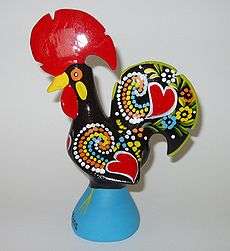Rooster of Barcelos
The Rooster of Barcelos (Portuguese, "Galo de Barcelos") is one of the most common symbols of Portugal.

Folk Tale
.jpg)
The Folk Tale of the Rooster of Barcelos[1] tells the story of a dead rooster's miraculous intervention in proving the innocence of a man who had been falsely accused and sentenced to death. The story is associated with the 17th-century calvary that is part of the collection of the Archeological Museum located in Paço dos Condes, a gothic-style palace in Barcelos, a city in the Braga District of northwest Portugal.
According to the tale, a landowner in Barcelos had silver stolen and the inhabitants of that city were looking for the person who had committed the crime. One day, a man from Galicia turned up and became suspect, despite his pleas of innocence. The Galician swore that he was merely passing through Barcelos on a Pilgrimage to Santiago de Compostela to complete a promise.
Nevertheless, the authorities arrested the man and condemned him to hang. The man asked them to take him in front of the judge who had condemned him. The authorities honoured his request and took him to the house of the magistrate, who was holding a banquet with some friends. Affirming his innocence, the man pointed to a roasted Rooster on top of the banquet table and exclaimed, "It is as certain that I am innocent as that rooster will crow when they hang me." The judge pushed aside his plate because he decided to not eat the rooster. But still, the judge ignored the appeal.
However, while the pilgrim was being hanged, the roasted rooster stood up on the table and crowed as predicted. Understanding his error, the judge ran to the gallows, to discover that the man had been saved from being hanged thanks to a poorly made knot in the rope. The man was immediately freed and sent off in peace.
Some years later, he returned to Barcelos to sculpt the Calvary (or Crucifix) to the Lord of the Rooster (Portuguese, "Cruzeiro do Senhor do Galo") in praise to the Virgin Mary and to Saint James. The monument is located in the Archaeological Museum of Barcelos.
Variations
In all cases, the folk tale of the Rooster of Barcelos is about a dead rooster that crows to prove an accused man's innocence. However, there are variations to the story. The following are some of the variations:
- The pilgrim is a guest whom the landowner invited to his banquet, where silver is stolen.
- The pilgrim stays at a local inn, and it is the greedy owner of the inn who falsely accuses the pilgrim of the crime.[2]
- There are two pilgrims, a father and his son. The son is accused, and the father pleads his innocence by calling on the rooster to crow.[3]
- The rooster crows as soon as the accused man declares it will, so the man is never taken to the gallows.
- The accused is not identified as being from Galicia.
- The miracle is located in La Rioja, Spain and associated to Saint Dominic de la Calzada.
The logo is also used by Nando's, an international casual dining restaurant chain.[4]
See also
| Wikimedia Commons has media related to Cock of Barcelos. |
- Symbols of Portugal
- Gallic rooster
References
- Lenda do Galo de Barcelos (Portuguese)
- "Lenda do Galo de Barcelos" (in Portuguese). Archived from the original on October 6, 2010.
- O Senhor do Galo de Barcelos e o Milagre do Enforcado (Portuguese), Infopédia (online). Porto: Porto Editora, 2003-2011. Retrieved on 2011 February 07.
- "Nando's Chicken and the Portuguese Rooster". www.saywhydoi.com.